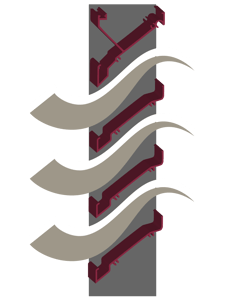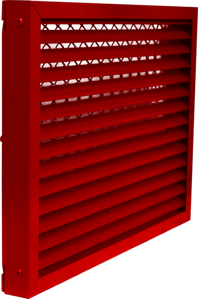In this article, we cover the ten important traits to consider when choosing the right louver. Learn what to look for in an effective louver and what those traits mean for the louver's performance.
Selecting Louvers for a Project
Louvers seem simple enough – they’re just blades in a frame – but there are a lot of key factors to consider when choosing a louver for a specific application. In this article, we discuss ten basic factors to consider when choosing the best louver for the task. Be prepared when deciding on louvers for your next project.
Louvers and their Applications
Certain factors will be more important based on what the louver will do and where it will go in your building, while other factors will be important across all louver applications. Louvers can also serve an aesthetic purpose, such as blocking vision lines into restricted areas, or for shading parts of the building from direct sunlight. These applications may not require considerations like airflow direction or face velocity. For louvers that protect an intake point for your HVAC system, these considerations will be crucial.
.webp?width=500&height=262&name=Louver%20Aesthetics%20-%20Body%20Image%20(resize).webp)
This article will focus on functional louvers used for protecting ventilation openings. We will break down these factors and explain why they are important. Before we go into the ten important traits, let’s start with three basics.
For more info on louver selection, check out these Newsstand articles:
- Five Things to Know When Choosing Louvers
- Louvers for Every Occasion? - Choosing for Various Applications
- Louvers by the Numbers
Start with the Big Three: Protection, Performance, and Aesthetic
All your louvers should do at least one of the following three things.
Protection
The louver should be designed to prevent debris and rainfall from infiltrating into your HVAC system. Several factors come into play here. A louver should provide protection, but its intended application will dictate how much protection is needed. Standard louvers can be tested for water penetration, which indicates their ability to reject water from light rainfall. Severe weather louvers will require testing for wind driven rain.
When any louver is tested, the results will be posted on the louver’s submittal along with an AMCA seal. This seal indicates the tests were verified complete by AMCA and that all test data is accurate. Learn more about AMCA's tests for severe weather with our Newsstand article on wind driven rain testing.
.webp?width=271&height=400&name=EA331VSL%20-%20Vertical%20Blade%20Storm%20Louver%20(Resize).webp)
Your application will determine the required protection. Buildings in areas with frequent storms will require louvers built for severe weather.
Louvers can also receive a screen accessory that prevents birds or insects from entering through the louver's free area. Insect screens will have smaller perforations than bird screens but will also have a greater effect on the louver’s air performance. If insects or birds are a problem, then you may need to add some screens to your louvers.
Protection and performance are always a balancing act. Over-protection may not be the best option, because you sacrifice air performance in the process. Inadequate protection could lead to water damage. Choose the level of protection that will best fit your application.
Performance
The louver should allow air flow through its free area with minimal resistance. All louvers will provide some resistance, but severe weather louvers and hurricane louvers will have more resistance than standard louvers.
.webp?width=267&height=400&name=EA%20605%20(Resize).webp)
Louvers protect ventilation openings, but that protection can come at a cost. Your louvers should not have a significant effect on your system's air performance.
This resistance is commonly referred to as pressure drop, or the loss of pressure as air passes through the louver. Factors such as free area, face velocity, and system effects like ductwork behind the louver will all affect the louver’s air performance in specific ways. Brush up on air performance with a quick read from our Condenser collection: Air Performance and Keeping the Flow
The primary function of every louver is to allow air through the opening, regardless of its application. It’s important to understand the balance between air flow and water protection. You should also understand the requirements of your application. You may need a louver that focuses on one aspect over the other.
Aesthetic
Louvers should fit the building's aesthetic. They should look good, wherever they're installed. This decision will involve the project’s overall aesthetic, as well as personal taste. Manufacturers will provide standard colors and color matching options, to ensure each louver meets your expectations. Louver finishes add color to any louver, but they can lose their luster over time. Click here for more on louver style and aesthetic.
Sun exposure can wear down any finish and fade the louver’s color. If your louver is installed in a coastal area, you will need to choose a finish that can resist salt spray. The type of finish you use will determine how long it stays true to the original color. Most louver finishes follow the American Architectural Manufacturer’s Association (AAMA) standards for powder coatings. Most standard louver finishes will adhere to AAMA 2604, while the more durable and longer-lasting finishes will meet AAMA 2605.
.webp?width=500&height=334&name=bogomil-mihaylov-Mp7ToxESnAo-unsplash%20(Resize).webp)
Louvers should fit the building's aesthetic. You can apply custom finishes onto the louvers to match the surrounding architecture or add some much-needed contrast.
Remember: protection, performance, and aesthetic. As you can see, there are many distinct factors to consider even in those three core properties. Now, let's look at the ten important traits of highly effective louvers.
Ten Important Traits of Highly Effective Louvers
It can be a daunting task to choose the right louvers for your project. To help you decide, here is a list of ten important traits you should consider when purchasing a louver.
1.) Louver Application
Know what your louver will do. For standard louvers, you will choose between ventilation applications, acoustical modulation, protection from light rainwater penetration, severe weather wind driven rain protection, or louvers specific for hurricane zones. For aesthetic or vision screen louvers, you will already have an idea in mind.
The louver's application will determine what factors you should focus on for the other considerations.
.webp?width=500&height=293&name=Buffalo%20Heights%20-%20Original%20(Resize).webp)
For example, a louver with a high beginning point of water penetration may also have a high pressure drop, which will have a negative impact on your system’s performance. Your system will work harder to get the same amount of air through, causing excessive and unnecessary strain on your entire system. However, your project may require extra rain resistance for that application. In this case, you would choose protection over performance.
You should always know the louver's application first. This consideration will help you focus on what to look for with the other considerations.
2.) Airflow Direction
.webp?width=300&height=388&name=Intake%20louver%20Airstream%20(Resize).webp)
Your next consideration should be airflow direction. If your louver will be used for ventilation, you will need to know if the louver will cover an intake point or an exhaust point on your building.
Intake louvers will be quite different from exhaust louvers and will have features tailored to specific types of flow. Since they take air into the system, you will need to consider how the louver rejects water and other unwanted elements.
For exhaust applications, you do not need to worry about water infiltration since exhaust air will push water away from the opening. An exhaust louver can have blades with smooth profiles set at 90° angles.
For intake louvers, you will need to consider the blade style, blade angle, and blade spacing. Each of these factors will affect how the louver performs. Intake louvers will need to strike a balance between air performance and protection from rainfall.
3.) Blade Style
.webp?width=300&height=483&name=Hubspot%20Blog%20Cover%20Image%20-%20Louver%20Graphics%20-%20Fixed%20vs%20Adjustable%20(Resize).webp)
Blades make the louver, and certain blades will be better suited for different applications. Louvers can have stationary blades, adjustable blades, or a combination of stationary and adjustable blades.
Blade profiles will determine the louver’s capabilities: choose straight profiles for air performance, baffle profiles to protect against water penetration, or chevron profiles for maximum protection from wind driven rain.
You may also choose to have blades with drainable troughs that siphon water through in-jamb channels and out of the louver. These drains are standard features on severe weather and hurricane louvers.
Check out our primer on louver blades for a full explanation of blade types.
4.) Blade Angle and Spacing
.webp?width=300&height=388&name=Louver%20Free%20Area%20Illustration%20(Resize).webp)
The angle of stationary blades and the space between them will directly affect the louver’s free area.
Intake louvers will have their blades angled upward towards the back of the louver, so that air can move along their profiles. Other elements, like rainwater, will need more air speed to make the same trip. A greater blade angle will typically provide more protection from rain and debris but will also have greater resistance to airflow.
More blade spacing translates to higher free area, which means better air performance.
Blade spacing is expressed as inches “on center” or O.C. The blade angle will be expressed in degrees.
5.) Louver Depth
This determines the depth of the louver’s frame, or how deep the louver’s body will sit in the opening. The necessary louver depth will depend on the opening receiving the louver. You can specify the width and height of the frame to fit the opening, but the depth will be a fixed measurement. Choosing a different louver depth often means choosing a different louver, but this isn't always the case.
Openings with thick walls can support a greater louver depth without needing extra support. However, you can install a deep louver into a shallow opening with louver supports. These accessories brace the louver against the opening and prevent it from falling out. They also provide additional support for the opening. If the application calls for a deep louver, then you have options available to install the louver you need.
In general, you should choose a louver depth that closely matches the depth of the opening. Otherwise, you may need to accommodate louver supports into the installation.
6.) Construction Materials
Louvers are typically made from extruded aluminum or galvanized steel. Louvers can be made from other materials to match an aesthetic or meet a special requirement. Ask the louver manufacturer for all available options.
The material of the louver will affect its weight, its overall durability, and its ability to accept certain finishes. Extruded aluminum louvers are lightweight and durable for most applications. Due to the porous nature of aluminum, these louvers can also receive the most finish options without trouble. Severe weather louvers are typically made from roll-formed aluminum.
.webp?width=500&height=333&name=EA662VSL%20-%20Mill%2c%20Lying%20flat%20(Resize).webp)
Galvanized steel and stainless-steel louvers are heavier and more durable than their aluminum counterparts, but they cannot receive all finish types due. Learn more about the three metals commonly used in louvers with this Newsstand article.
Louvers made from heavy gauge materials, such as stainless steel, will require additional support.
7.) Air Volume & Face Velocity

Air volume refers to the amount of air flowing through the louver, expressed in CFM (cubic feet per minute).
Face velocity is the speed of the air flow across the louver’s face. Face velocity is typically expressed in FPM (feet per minute).
These two factors will help you determine the louver's air performance, which dictates how the louver handles air flow. Air volume and face velocity are important to all louvers.
8.) Performance Requirements
Most louvers share the same set of performance requirements but focus on one requirement over the others. Certain louvers will require a particular set of performance requirements, such as air leakage for adjustable blade louvers or dynamic insertion loss for acoustical louvers. The data for these traits will determine the louver's effectiveness for its intended application.
For acoustical louvers, the dynamic insertion loss will determine how well the louver can attenuate and dampen noise. Air leakage will determine how well the adjustable louver blocks airflow when closed. When air leaks through closed blades, it can cause inefficiency in other parts of the system.
Understand the performance requirements of your application before selecting a louver.
9.) Screen Type
Louvers can have two distinct types of screens: insect screen or bird screen. Insect screens have smaller perforations for blocking small critters, while bird screens have large holes for keeping birds out of your louvers. Insect screens will have a greater effect on air performance than bird screens.
These screens are optional. However, a louver screen will come in handy if the area surrounding the opening has lots of bugs or birds. Learn more with our article on louver screens.
10.) Finish Type and Color
 Finish type will depend on where the louver is installed. A louver subjected to direct sunlight on a regular basis, or a louver installed in a coastal region, will require a heavy-duty finish that complies with AAMA 2605.
Finish type will depend on where the louver is installed. A louver subjected to direct sunlight on a regular basis, or a louver installed in a coastal region, will require a heavy-duty finish that complies with AAMA 2605.
Louvers in shaded areas may be able to use the standard finish that complies with AAMA 2604. Due to the nature of the finishing process, steel louvers will not have the same color range as aluminum louvers.
You will want to choose colors that work with the overall aesthetic of your building. Most manufacturers will offer color matching with their finishes.
These ten traits are important, but there may be additional specific factors to consider in each application. External factors may also play a role in the application, such as the wind conditions in the area surrounding the louver. Compile a full list of factors and considerations before deciding on the louver.
Always carefully consider what you need the louver to do before making any decisions.
.webp?width=606&height=307&name=MCDLG%20Blog%20-%203%20Types%20-%20Combined%20(Resize).webp)
Do you take these ten traits into account when choosing a louver? What are some other considerations you might have? Discuss your thoughts on louvers in the Comments section below. We want to hear from you!
Do you have any questions? Ask MCDLG. We're here to help. Click the button below to contact us. Let's work together!

.webp?width=91&height=70&name=MCDLG%20Logo%20(Resize).webp)
.webp)




